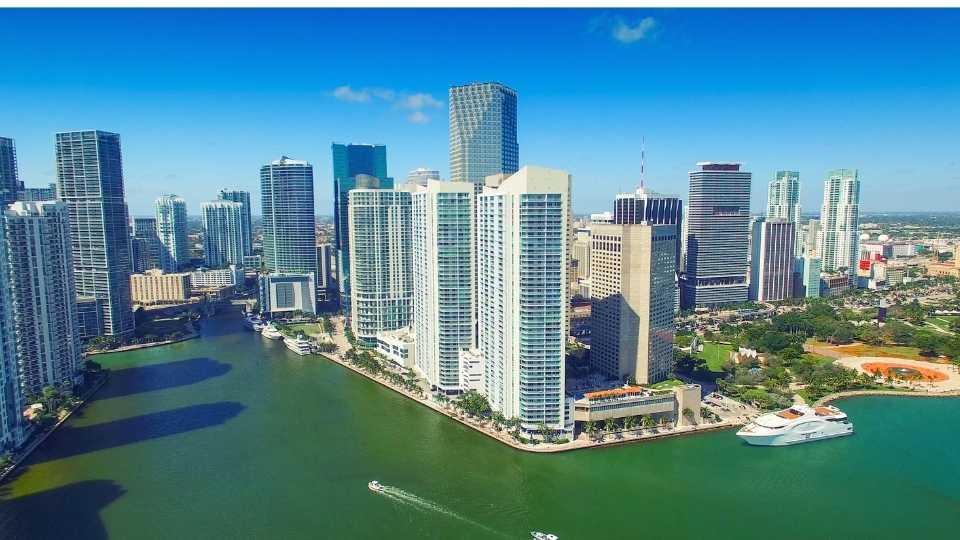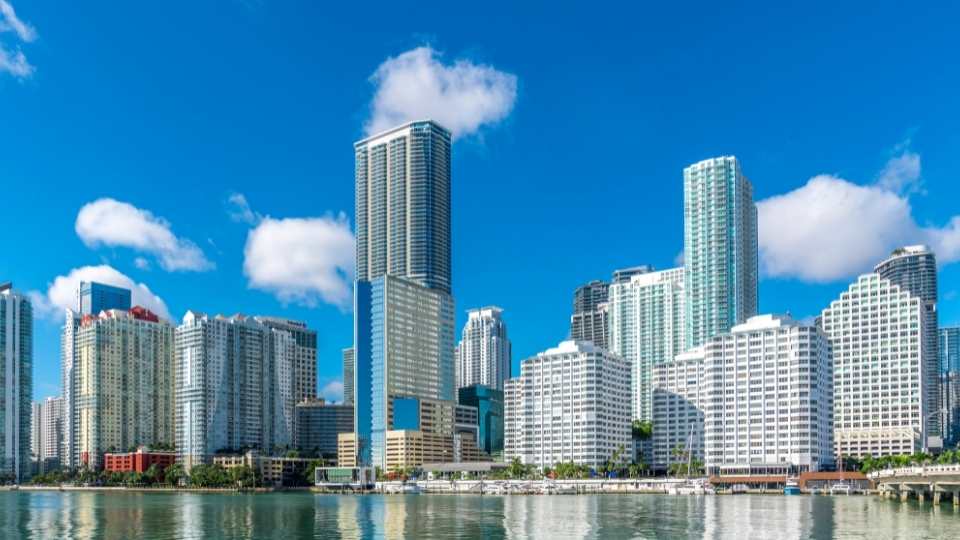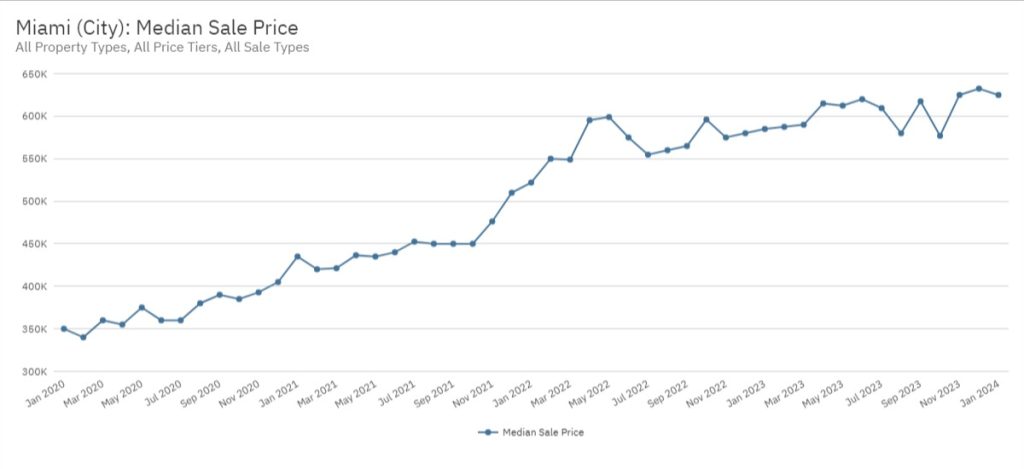
Miami, known for its vibrant culture and beautiful beaches, offers residents a unique blend of urban living and seaside relaxation. With a climate that boasts year-round sunshine, it’s no wonder that this South Florida city attracts people from all walks of life. However, potential residents should be prepared for the cost of living, which is approximately 17% higher than the national average. This reflects on everyday expenses such as utilities, groceries, and transportation, though it’s offset by a food scene that’s both diverse and exquisite.
The real estate market in Miami presents an array of opportunities and challenges. While property taxes are relatively low, averaging around 1.02% of a property’s assessed value, housing prices have been on the rise, making it difficult to find a median-priced home below $300,000. Despite this, Miami’s allure remains strong with its lower than average cost of living compared to other major cities like New York and Los Angeles, where a monthly budget of about $2,500 could secure an apartment in this sought-after location.
Economic considerations are equally significant when contemplating the move to Miami as the cost of living has risen dramatically over the past several years. As with any city, it is crucial for newcomers to weigh the lifestyle benefits against the economic demands to make the most informed decision about residing in Miami.
The Magic City: Understanding Miami
Miami, known as the Magic City, offers a unique blend of geographic diversity, a warm climate, rich cultural history, and a dynamic economic environment. It is a hub for various cultures and a center of economic activity in Florida, characterized by its favorable weather conditions and diverse job opportunities.
Geographic and Cultural Overview
Miami is situated in the southeastern part of Florida and is a central point where cultures from Latin America, the Caribbean, South America, Asia, and Europe converge, making it a true melting pot. This diversity is reflected in the city’s neighborhoods, such as Little Havana and Little Haiti, offering an array of cultural experiences. Miami’s shoreline is lined with picturesque beaches and is proximate to the United States’ only coral reef.
Key Demographics:
- Diversity: High, with significant Latin American and Caribbean influence
- Neighborhoods: Cultural enclaves like Little Havana and Little Haiti
Weather Patterns and Climate
Miami’s climate is classified as tropical monsoon, with a marked warm and humid season from May through October and a cooler dry season from November through April. Hurricane season falls between June and November, a critical period for the city due to its coastal location. Despite this, Miami is often referred to as the Sunshine State, owing to its generally sunny weather.
Typical Climate Details:
- Temperature: Average high of 84°F (29°C), low of 68°F (20°C)
- Humidity: High year-round
History and Culture
Miami boasts a rich history with significant influence from Cuban culture evident in the city’s architecture, food, and annual festivals. The city has an active art scene, hosting the renowned Art Basel Miami Beach, and features historic districts with preserved architecture. Sites like Little Havana provide an immersive experience of Cuban and other Caribbean cultures within the United States.
Cultural Highlights:
- Art Scene: Art Basel Miami Beach, numerous galleries, and street art like Wynwood Walls
- Historic Sites: Art deco buildings, museums, and theaters
Economic Landscape
Miami has garnered a reputation as a gateway for international businesses and is recognized for its growing financial district. The absence of Florida state income tax makes it an attractive location for both businesses and professionals. The city’s job market is robust, with a focus on tourism, finance, real estate, and international trade.
Economic Features:
- Income Tax: No state income tax in Florida
- Job Market: Diverse opportunities with a focus on tourism and finance

Settling in Miami
Miami, with its vibrant culture and growing economy, has become an attractive city for many seeking new opportunities. This guide will help you understand the essentials of living expenses, housing market trends, and selecting a neighborhood that fits your lifestyle.
The Cost of Living
Miami’s cost of living is 14% higher than the national average, mainly driven by housing and entertainment costs. A single person’s monthly expenses, excluding rent, exceed $1,500, while a family of four may spend more than $4,000 without considering mortgage or rent payments. Utilities, such as electricity, heating, cooling, and water, for an two-bedroom apartment average $145 per month, which is slightly higher than in some other cities.
Miami’s Housing and Real Estate
The real estate market in Miami has observed an increase, with housing prices rising 7.1% over the previous year. A single-family is challenging to find under $400,000, and the market shows signs of continued growth. Rent, a significant factor in cost of living, varies greatly, but the average rent in high-demand areas like Brickell or Downtown Miami can exceed $4,000 a month for a standard one-bedroom apartment.
Finding the Right Neighborhood
Choosing the right neighborhood is crucial when settling in Miami. For a cosmopolitan vibe, consider Brickell or Downtown Miami. Coconut Grove offers a laid-back atmosphere with lush greenery and bay views. Wynwood is known for its street art and trendy spots, while Coral Gables features historic homes and the University of Miami. More affordable neighborhoods include Kendall and South Miami. Those looking for suburban comfort might explore Pinecrest or Overtown. For a vibrant cultural experience, Little Havana is iconic and rich in history. Each area varies in cost, amenities, and lifestyle, making Miami a mosaic of neighborhoods catering to diverse preferences.

Lifestyle and Entertainment
Miami offers an exhilarating mix of leisure, culture, and dining that caters to a diverse population and their vibrant lifestyles. Its world-renowned beaches, thriving art scene, and exceptional culinary offerings create a dynamic entertainment landscape.
Leisure and Recreation
Miami’s outdoor lifestyle is epitomized by its stunning beaches and a plethora of water sports. South Beach delivers a quintessential Miami beach experience with active volleyball games and sun-soaked relaxation. For golf enthusiasts, the city boasts top-tier golf courses known for their beauty and challenge. The area’s warm climate allows for year-round outdoor recreation, including visits to sprawling public parks like Key Biscayne and tropical gardens that host numerous festivals.
- Beaches: South Beach, Virginia Key Beach
- Water Sports: Jet skiing, paddleboarding, snorkeling
- Golf: Miami Beach Golf Club, Crandon Golf at Key Biscayne
- Public Parks: Bayfront Park, Key Biscayne
Arts and Culture Scene
Miami’s arts and culture scene reflects its rich history and the influence of Latin America and the Caribbean. The Wynwood neighborhood, renowned for its colorful street murals, offers an immersive experience in contemporary art. The Perez Art Museum showcases modern and contemporary works, enriching the city’s artistic landscape. Neighborhoods like Little Havana bring Cuban culture to life, where one can indulge in authentic music, art, and cocktails.
- Wynwood: Wynwood Walls, art galleries, artisanal boutiques
- Museums: Pérez Art Museum Miami, Vizcaya Museum and Gardens
- Cultural Districts: Little Havana, Coral Gables
The Culinary Journey
Miami’s dining scene is as diverse as its population, offering an array of restaurants representing global cuisines with a heavy emphasis on Latin flavors. The city excels in both high-end dining and authentic street food, providing a comprehensive culinary journey. Food enthusiasts can revel in the vast selection of Latin American dishes, especially Cuban food in areas like Little Havana. Cocktails derived from a blend of local and international influences can be found in the city’s lively nightlife and entertainment venues.
- Dining: Joe’s Stone Crab, Versailles Restaurant
- Cuisine: Latin American, Caribbean, Seafood, Fusion
- Cocktails: Mojito, Cubanito, craft bars
Practical Insights for Living in Miami
In Miami, residents navigate a vibrant cityscape marked by diverse transportation options, esteemed educational institutions, and a healthcare system that serves an eclectic population. This section spotlights the essentials for commuting, studying, and staying healthy in the Magic City.
Transportation and Commuting
Miami’s transportation network relies heavily on cars, and traffic congestion is a regular challenge, particularly on highways like I-95. For those working in Downtown or Brickell, considering proximity to employment can significantly reduce commute times. Public transit options include the Metromover, which is free and connects areas within Downtown Miami, as well as buses and the Metrorail system. The Miami International Airport provides extensive domestic and international connectivity.
- Primary Commuting Modes:
- Personal Car
- Metrorail
- Metromover
- Bus
Education Systems and Opportunities
Education in Miami benefits from both public and private institutions. The University of Miami stands out as a center for higher education and research. Families may choose from a myriad of private schools that cater to a diverse set of educational philosophies. Public schools in Miami-Dade County offer magnet programs and International Baccalaureate diplomas, among other specialized pathways.
- Educational Highlights:
- University of Miami: Renowned higher education with a broad range of programs
- Private Schools: Varied options with a focus on diverse educational needs
Healthcare and Safety
Healthcare in Miami is robust, featuring hospitals that are recognized for their quality services and specialized care. Residents can choose from a variety of healthcare providers suited to the city’s diversity. Safety in Miami mirrors that of any large metropolitan area; it’s advisable to be aware of local safety information and trends, especially for those new to city living.
- Healthcare Facilities:
- Public and Private Hospitals
- Specialized Medical Centers
- Walk-in Clinics

Other Thoughts
Miami, often referred to as the Magic City, boasts a vibrant lifestyle that appeals to many. Its diversity and culture offer a unique living experience, with a melting pot of languages and customs enriching daily life. The city’s food scene is impressive, with a wide array of international cuisine at one’s fingertips.
Miami’s Financial Aspects:
- Tax Benefits: Residents enjoy having no state income tax, which can lead to significant savings.
- Property Taxes: At an average rate of 1.02%, property taxes are considered low compared to many urban areas.
- Cost of Living: It’s essential to note that the cost is 17% higher than the national average, affecting expenses like groceries and utilities.
Transportation:
- For getting around, a car is highly recommended. However, alternatives exist, such as public transport or rental services, to navigate the city and its surroundings.
In summary, when considering Miami as a destination, potential residents should weigh the vibrant lifestyle against the higher cost of living. The tax advantages may offset some expenses, adding to the appeal of this sunlit, diverse coastal city. Being well-informed about these aspects will help one make a knowledgeable decision about embracing the Miami lifestyle.

Are you interested in owning a home in Florida?
If the allure of sun-kissed beaches, vibrant communities, and year-round warmth speaks to your heart, owning a home in Florida might just be your next great adventure!
To assist our audience with buying or selling a vacation property, Endless Summer has affiliated with Quantum Realty Advisors, Inc. (“Quantum”) which is a licensed Florida real estate company that has been in business since 1998. Whether you’re dreaming of a cozy beachfront bungalow, a sprawling estate nestled against the backdrop of palm trees, or a chic urban condo in the heart of a bustling city, Quantum will help make that dream a reality.
From less than $500,000 to more than $5 million, the Quantum team will be happy to assist with your vacation home buying process and can be reached at 561.584.8555.
Quantum Realty Advisors, Inc.
4440 PGA Boulevard, Suite 308 | Palm Beach Gardens, FL 33410
561.584.8555

Quantum’s experienced real estate advisors will take the time to discuss exactly what your are looking for in a vacation home as well your what will fit into you budget. And when you are ready to begin, they will be with you every step of the way. Click here to learn more about Quantum.
